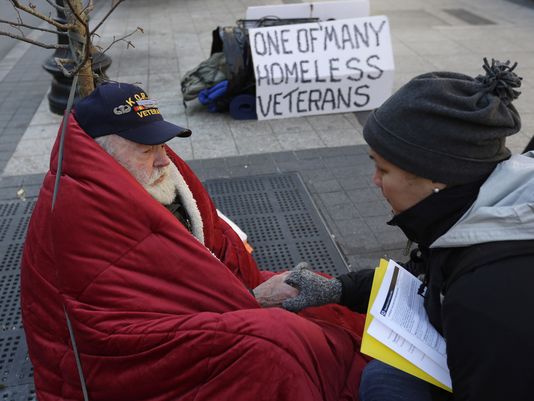This is a thought provoking article I read online at USA Today and wanted to share with you:
“Homelessness can and must be ended. But it won’t be if our leaders report that there is no crisis.”

Homeless Korean War veteran Thomas Moore, 79, speaks with outreach coordinator Romeena Lee in Boston in November.
(Photo: Steven Senne, AP)
Homeless problem bigger than our leaders think
Report misleads on those without shelter
An article by Maria Foscarinis posted at 7:35 p.m. EST January 16, 2014
The Great Recession is causing continued hardship for many Americans. Yet a recent report found thathomelessness is down. I wish that were true. The research, from the Department of Housing and Urban Development, says homelessness decreased by nearly 4% over the past year. But it doesn’t actually measure homelessness.
Instead, it looks at people who are in shelters or transitional housing and the number of people who are outside on a single January night. Not included are those doubled up or couch surfing because they can’t afford their own place. Neither are people in hospitals, mental health or substance abuse centers, jails or prisons with nowhere to go upon release.
One night?
The problem isn’t just the count’s narrow scope; its methods are flawed. For the count of people in shelters and transitional housing, service providers report their numbers on the designated night. But this just measures capacity. If the number goes down, this could mean either fewer homeless or fewer beds for them.
The “street” part of the count tries to measure unmet need by counting people in places “not meant for human habitation,” such as streets, parks, alleys, subway tunnels, all-night movie theaters, abandoned buildings, roofs, stairwells, caves, campgrounds and vehicles.
HUD sets the guidelines, but communities have discretion in how they count. A few use sophisticated statistical methods. Most simply organize volunteers to fan out and make judgments about who is homeless, avoiding locations where they feel unsafe. How even the best prepared volunteers can cover large expanses in a few hours is anyone’s guess.
Local policies can also affect the count. For example, cities are increasingly making it a crime to sleep in public places. If the street count goes down, is it because need is down or because there is greater cause to fear arrest, driving people further into hiding?
Punishing the homeless
Similarly, in some cities, families seeking shelter can be threatened with removal of their children; families living outside have extra incentive to avoid detection.
To its credit, the Obama administration has made a commitment to ending homelessness and, to measure progress, it needs data. Methods pioneered in New York City that statistically adjust for the built-in inaccuracies of the “street” count could significantly improve it. But the data must not only be accurate; they must also be theright data, and that’s the larger issue. Homelessness happens over time, not on a single night — and it reflects a deeper crisis.
According to Harvard’s Joint Center for Housing Studies, low-income households suffer an unprecedented housing cost burden, forcing many to choose between rent and food. Too often, homelessness is the result.
Another reason to doubt HUD’s reporting: On Thursday, the Department of Veterans Affairs released statistics showing that homelessness among Iraq and Afghanistan war veterans is sharply rising despite new efforts to help them.
Ending homelessness requires closing the gap between the need for housing and its availability. It requires recognizing housing as a basic human right, and enacting policies to ensure it is available.
Homelessness can and must be ended. But it won’t be if our leaders report that there is no crisis.
Maria Foscarinis, a lawyer, is executive director of the National Law Center on Homelessness & Poverty.
SOURCE


